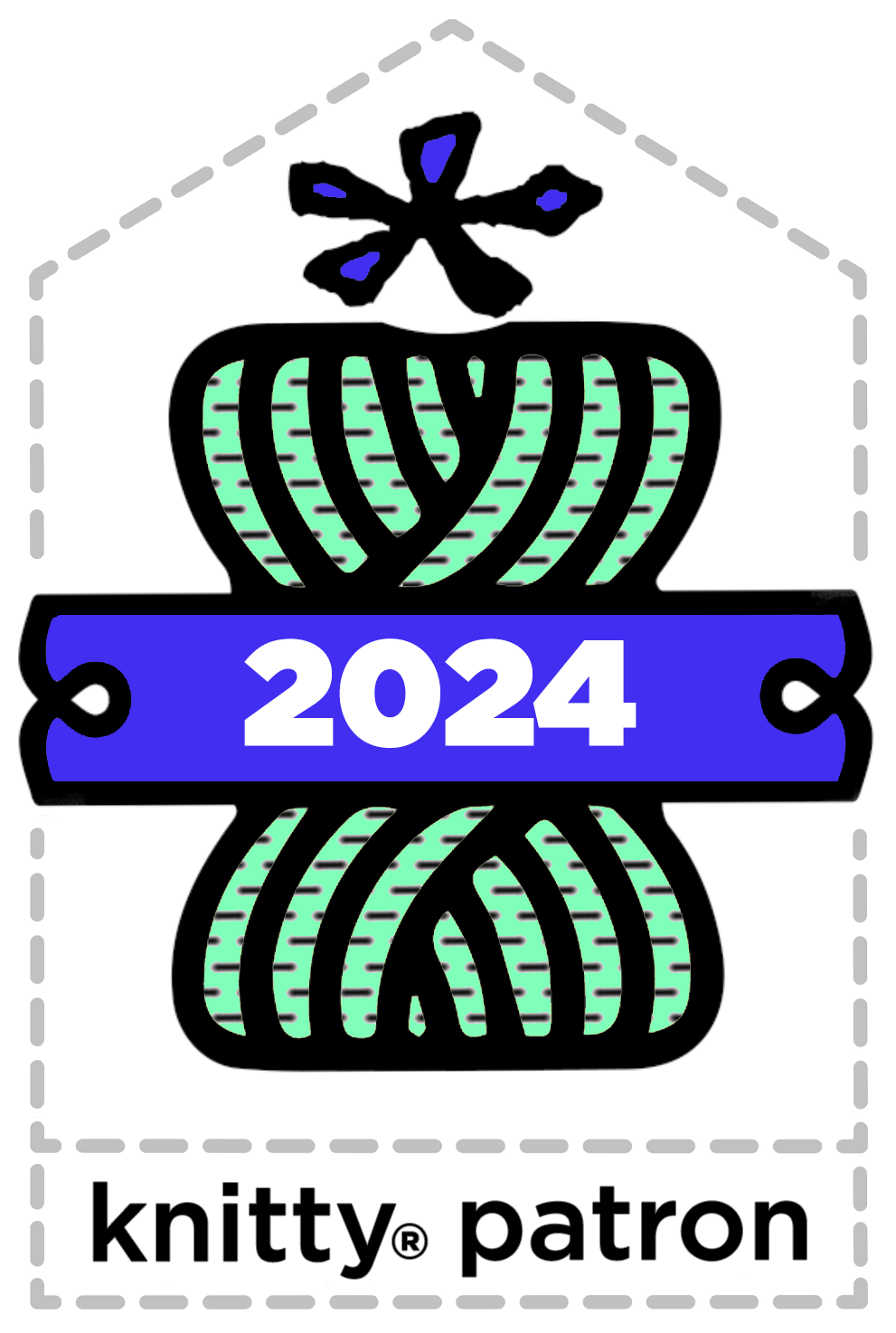Valeriana, a free knitting pattern from Knitty.com.
INTRODUCTION
Valeriana
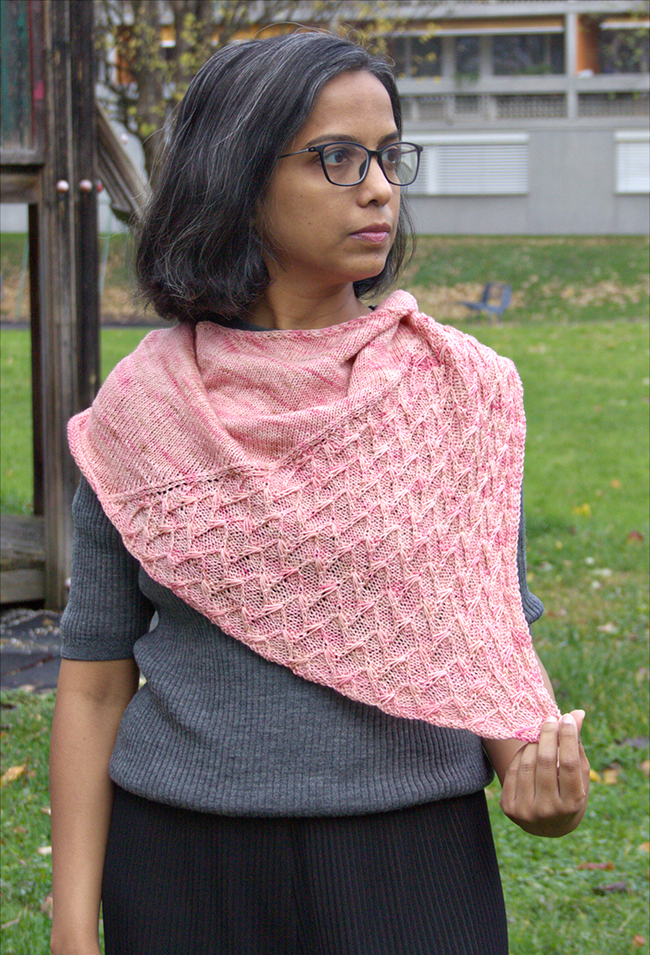 by Anjali M
by Anjali M
![]()
During my week-long stay in Milano, Italy, as I was walking down a charming street, I spotted this very inviting yarn store named "Hydrangea Yarns". Naturally, I walked in and the store owner and I struck up a conversation. When I shared that I am a knitwear designer, she generously offered a skein of her own hand-dyed yarn for me to design something with.
The lovely skein with the most beautiful shades of pink stayed quietly in my stash until I was inspired what to knit with it – again in Italy. As I was sitting by Lake Maggiore enjoying a sunrise, I swatched and completed knitting the shawl in a week's time. The result is Valeriana. The pink hues and the undulating lace reminds me of Valerian flowers and to pay my tribute to the strong Italian connection of this design, I named it after the Italian word – Valeriana.
Instructions for the shawl come in two sizes. The smaller size (shown in pink) is knit using one skein of fingering-weight yarn, while the larger size (shown in violet below) is knit using two skeins of fingering-weight yarn.
 model: Anjali M
model: Anjali M
 photos: Anjali M
photos: Anjali M
SIZE
S[L]
FINISHED MEASUREMENTS
Width (top edge): 35[49] inches/ 89[124.5] cm
Depth at deepest point: 20[31] inches/ 51[79] cm
Note: This pattern is adjustable for different gauge and yardage – see yarn information below.
MATERIALS
Yarn
![]() Small pink sample shown above in:
Small pink sample shown above in:
Hydrangea Simply Sock Thick [75% Merino, 25% Nylon; 437 yd/400 m per 100g skein] color: Fading Rose; 1 skein
![]() Large violet sample shown below in:
Large violet sample shown below in:
Walk Collection Linea [50% Alpaca, 25% Silk, 25% Linen/Flax; 437 yd/400 m per 100g skein] color: Iris; 2 skeins
Yarn Characteristics
![]() Choose a solid, semi-solid, speckled, or gradient yarn. Avoid highly variegated yarns as the lace might get lost in the busy colors. The pink sample is knit using a smooth merino/nylon sock yarn, and the violet sample is knit using a luscious blend of alpaca, silk and linen fingering-weight yarn. This shawl can be knit with laceweight, light-fingering or sport yarn which would change the drape of the shawl and yardage requirement. Use smaller or larger needles if you are using a thinner or heavier yarn, respectively.
Choose a solid, semi-solid, speckled, or gradient yarn. Avoid highly variegated yarns as the lace might get lost in the busy colors. The pink sample is knit using a smooth merino/nylon sock yarn, and the violet sample is knit using a luscious blend of alpaca, silk and linen fingering-weight yarn. This shawl can be knit with laceweight, light-fingering or sport yarn which would change the drape of the shawl and yardage requirement. Use smaller or larger needles if you are using a thinner or heavier yarn, respectively.
Recommended needle size
[always use a needle size that gives you the gauge listed below - every knitter's gauge is unique]
![]() US #3/3.25mm circular needle, 32 inch/80 cm or longer to get the recommended gauge
US #3/3.25mm circular needle, 32 inch/80 cm or longer to get the recommended gauge
![]() US #5/3.75mm circular needles, 32 inch/80 cm or longer for binding off
US #5/3.75mm circular needles, 32 inch/80 cm or longer for binding off
Notions
![]() 1 stitch marker
1 stitch marker
![]() blocking mat
blocking mat
![]() blocking pins
blocking pins
![]() optional flexible blocking wires
optional flexible blocking wires
![]() yarn needle
yarn needle

GAUGE
23 sts/34 rows = 4 inches/10 cm in stockinette stitch
23 sts/34 rows = 4 inches/10 cm in pattern stitch
Note: It's not crucial to work to the gauge specified for this project, but a difference in gauge can change the look of the fabric, will result in a different finished size, and may affect yardage required.
PATTERN NOTES
[Knitty's list of standard abbreviations and techniques can be found here.]
M1L: Insert left needle, from front to back, under strand of yarn which runs between last stitch on left needle and first stitch on right needle; knit this stitch through back loop. 1 stitch increased.
Sl 1: All stitches should be slipped purlwise with yarn held to front of work; take the yarn to the back to knit the next stitch.
Lace bind off: K1, *k1; insert the tip of the left needle into the fronts of these two stitches from left to right (as if to do an SSK decrease), and knit them together from that position; repeat from * until all sts have been worked.
Lace Bind Off
LLEk1tbl (LLEk1tbl) (Video tutorial)
This is worked twice in succession, on adjacent RS rows in the same place.
The first time it's worked, insert right needle into the previous knit column (that is, the fourth stitch counting back on the right needle), 4 rows below and draw up a loop. There is a new stitch on the right needle. Knit into the back of the next stitch.
The second time it's worked, insert the right needle into the same stitch as the previous RS row (that is, the fourth stitch counting back on the right needle, 6 rows below). This stitch is highlighted in purple in the chart.
K1 tbl & Right-leaning elongated stitch (k1tblRLE) (Video tutorial)
Knit into the back of the next stitch.
The first time it's worked, insert right needle into the next knit column (that is, the fourth stitch counting ahead on the left needle), 4 rows below and draw up a loop. There is a new stitch on the right needle.
On the second time it's worked, insert the right needle into the same stitch as the previous RS row (that is, the fourth stitch counting back on the right needle, 6 rows below). This stitch is highlighted in purple in the chart.
CHARTS
View and download CHARTs here: SETUP chart | MAIN chart
Setup Pattern
Work from charted or written instructions as you prefer.
Note: In Rows 11, 13, 17, 19, 23, 25, 29, 31 you create an extra stitch. This extra stitch isn't specifically shown on the chart, pay attention to the instructions for the two special increases – they include making the new stitch from four rows below, and working the adjacent stitch tbl. On the following row, the extra stitch is decreased away with p2tog.
Row 1 [RS]: K1, m1l, k3.
Row 2 [WS]: Sl, k1, p3.
Row 3: K1, m1l, p1, k1 tbl, k2.
Row 4: Sl, k1, p1, k2, p1.
Row 5: K1, m1l, p2, k1 tbl, k2.
Row 6: Sl, k1, p1, k3, p1.
Row 7: K1, m1l, p3, k1 tbl, k2.
Row 8: Sl, k1, p1, k3, p2.
Row 9: K1, m1l, k1 tbl, p3, k1 tbl, k2.
Row 10: Sl, k1, p1, k3, p1, k1, p1.
Row 11: K1, m1l, p1, k1 tbl, p3, (LLEk1tbl), k2.
Row 12: Sl, k1, p2tog, k3, p1, k2, p1. 10 sts.
Row 13: K1, m1l, p2, k1 tbl, p3, (LLEk1tbl), k2.
Row 14: Sl, k1, p2tog, (k3, p1) twice.
Row 15: K1, m1l, (p3, k1 tbl) twice, k2.
Row 16: Sl, k1, (p1, k3) twice, p2.
Row 17: K1, m1l, (k1tblRLE
).
Row 18: Sl, k1, (p1, k3) twice, p2tog, p2. 13 sts.
Row 19: K1, m1l, p1, (k1tblRLE), (p3, k1 tbl) twice, k2. 15 sts.
Row 20: Sl, k1, (p1, k3) twice, p2tog, k2, p1. 14 sts.
Row 21: K1, m1l, p2, (k1 tbl, p3) twice, k1 tbl, k2. 15 sts.
Row 22: Sl, k1, (p1, k3) three times, p1.
Row 23: K1, m1l, (p3, k1 tbl) twice, p3, (LLEk1tbl), k2. 17 sts.
Row 24: Sl, k1, p2tog, (k3, p1) three times, p1. 16 sts.
Row 25: K1, m1l, (k1 tbl, p3) three times, (LLEk1tbl), k2. 18 sts.
Row 26: Sl, k1, p2tog, (k3, p1) three times, k1, p1. 17 sts.
Row 27: K1, m1l, p1, (k1 tbl, p3) three times, k1 tbl, k2. 18 sts.
Row 28: Sl, k1, (p1, k3) three times, p1, k2, p1.
Row 29: K1, m1l, p2, k1 tbl, p3, (k1tblRLE), (p3, k1 tbl) twice, k2. 20 sts.
Row 30: Sl, k1, (p1, k3) twice, p2tog, (k3, p1) twice. 19 sts.
Row 31: K1, m1l, p3, k1 tbl, p3, (k1tblRLE), (p3, k1 tbl) twice, k2. 21 sts.
Row 32: Sl, k1, (p1, k3) twice, p2tog, k3, p1, k3, p2. 20 sts.
Row 33: K1, m1l, (k1 tbl, p3) four times, k1 tbl, k2. 21 sts.
Row 34: Sl, k1, (p1, k3) four times, p1, k1, p1.
Main Pattern
Work from charted or written instructions as you prefer.
Row 1 (RS): K1, m1l, p1, k1 tbl, p3, (k1 tbl, p3, LLEk1tbl, p3) to last 7 sts, k1 tbl, p3, LLEk1tbl, k2.
Row 2 (WS): Sl, k1, p2tog, k3, p1, (k3, p2tog, k3, p1) to last 7 sts, k3, p1, k2, p1.
Row 3: K1, m1l, p2, k1 tbl, p3, (k1 tbl, p3, LLEk1tbl, p3) to last 7 sts, k1 tbl, p3, LLEk1tbl, k2.
Row 4: Sl, k1, p2tog, k3, p1, (k3, p2tog, k3, p1) to last 8 sts, (k3, p1) twice.
Row 5: K1, m1l, p3, (k1 tbl, p3) to last 3 sts, k1 tbl, k2.
Row 6: Sl, k1, p1, (k3, p1) to last st, p1.
Row 7: K1, m1l, k1 tbl, p3, k1tblRLE, p3, (k1 tbl, p3, k1tblRLE, p3) to last 7 sts, k1 tbl, p3, k1 tbl, k2.
Row 8: Sl, k1, p1, k3, p1, (k3, p2tog, k3, p1) to last 2 sts, k1, p1.
Row 9: K1, m1l, p1, k1 tbl, p3, k1tblRLE, p3, (k1 tbl, p3, k1tblRLE, p3) to last 7 sts, k1 tbl, p3, k1 tbl, k2.
Row 10: Sl, k1, p1, k3, p1, (k3, p2tog, k3, p1) to last 3 sts, k2, p1.
Row 11: K1, m1l, p2, (k1 tbl, p3) to last 3 sts, k1 tbl, k2.
Row 12: Sl, k1, p1, (k3, p1) to end.
Row 13: K1, m1l, p3, k1 tbl, p3, LLEk1tbl, p3, (k1 tbl, p3, LLEk1tbl, p3) to last 7 sts, k1 tbl, p3, LLEk1tbl, k2.
Row 14: Sl, k1, p2tog, k3, p1, (k3, p2tog, k3, p1) to last 5 sts, k3, p2.
Row 15: K1, m1l, (k1 tbl, p3) twice, LLEk1tbl, p3, (k1 tbl, p3, LLEk1tbl, p3) to last 7 sts, k1 tbl, p3, LLEk1tbl, k2.
Row 16: Sl, k1, p2tog, k3, p1, (k3, p2tog, k3, p1) to last 6 sts (k3, p1), k1, p1.
Row 17: K1, m1l, p1, (k1 tbl, p3) to last 3 sts, k1 tbl, k2.
Row 18: Sl, k1, p1, (k3, p1) to last 3 sts, k2, p1.
Row 19: K1, m1l, p2, k1tblRLE, p3, k1 tbl, p3, k1tblRLE, p3, (k1 tbl, p3, k1tblRLE, p3) to last 7 sts, k1 tbl, p3, k1 tbl, k2.
Row 20: Sl, k1, p1, k3, p1, (k3, p2tog, k3, p1) to end.
Row 21: K1, m1l, p3, (k1tblRLE, p3, k1 tbl, p3) to last 3 sts, k1 tbl, k2.
Row 22: Sl, k1, p1, k3, p1, (k3, p2tog, k3, p1) to last st, p1.
Row 23: K1, m1l, (k1 tbl, p3) to last 3 sts, k1 tbl, k2.
Row 24: Sl, k1, p1, (k3, p1) to last 2 sts, k1, p1.
Row 25: K1, m1l, p1, (k1 tbl, p3, LLEk1tbl, p3) twice, (k1 tbl, p3, LLEk1tbl, p3) to last 7 sts, k1 tbl, p3, LLEk1tbl, k2.
Row 26: Sl, k1, p2tog, k3, p1, (k3, p2tog, k3, p1) to last 3 sts, k2, p1.
Row 27: K1, m1l, p2, k1 tbl, p3, (LLEk1tbl, p3, k1 tbl) to last 3 sts, LLEk1tbl, k2.
Row 28: Sl, k1, p2tog, k3, p1, (k3, p2tog, k3, p1) to last 4 sts, k3, p1.
Row 29: K1, m1l, (p3, k1 tbl) to last 2 sts, k2.
Row 30: Sl, k1, p1, (k3, p1) to last st, p1.
Row 31: K1, m1l, (k1tblRLE, p3, k1 tbl, p3) to last 3 sts, k1 tbl, k2.
Row 32: Sl, k1, p1, (k3, p1, k3, p2tog) to last 2 sts, k1, p1.
Row 33: K1, m1l, p1, (k1tblRLE, p3, k1 tbl, p3) to last 3 sts, k1 tbl, k2.
Row 34: Sl, k1, p1, k3, p1, (k3, p2tog, k3, p1) to last 7 sts (not including the elongated stitch), k3, p2tog, k2, p1.
Row 35: K1, m1l, p2, (k1 tbl, p3) to last 3 sts, k1 tbl, k2.
Row 36: Sl, k1, p1, (k3, p1) to end.
Row 37: K1, m1l, p3, k1 tbl, (p3, k1 tbl, p3, LLEk1tbl) to last 2 sts, k2.
Row 38: Sl, k1, (p2tog, k3, p1, k3, p1) to last 5 sts, k3, p2.
Row 39: K1, m1l, k1 tbl, p3, k1 tbl, (p3, k1 tbl, p3, LLEk1tbl) to last 2 sts, k2.
Row 40: Sl, k1, (p2tog, k3, p1, k3) to last 7 sts, p1, k3, p1, k1, p1.
Row 41: K1, m1l, p1, (k1 tbl, p3) to last 3 sts, k1 tbl, k2.
Row 42: Sl, k1, p1, (k3, p1) to last 3 sts, k2, p1.
Row 43: K1, m1l, p2, (k1 tbl, p3, k1tblRLE, p3) to last 7 sts, k1 tbl, p3, k1 tbl, k2.
Row 44: Sl, k1, p1, k3, p1, (k3, p2tog, k3, p1) to last 4 sts, k3, p1.
Row 45: K1, m1l, (p3, k1 tbl, p3, k1tblRLE) to last 10 sts, (p3, k1 tbl) twice, k2.
Row 46: Sl, k1, p1, k3, p1, (k3, p2tog, k3, p1) to last 5 sts, k3, p2.
Row 47: K1, m1l, (k1 tbl, p3) to last 3 sts k1 tbl, k2.
Row 48: Sl, k1, p1, (k3, p1) to last 2 sts, k1, p1.
DIRECTIONS
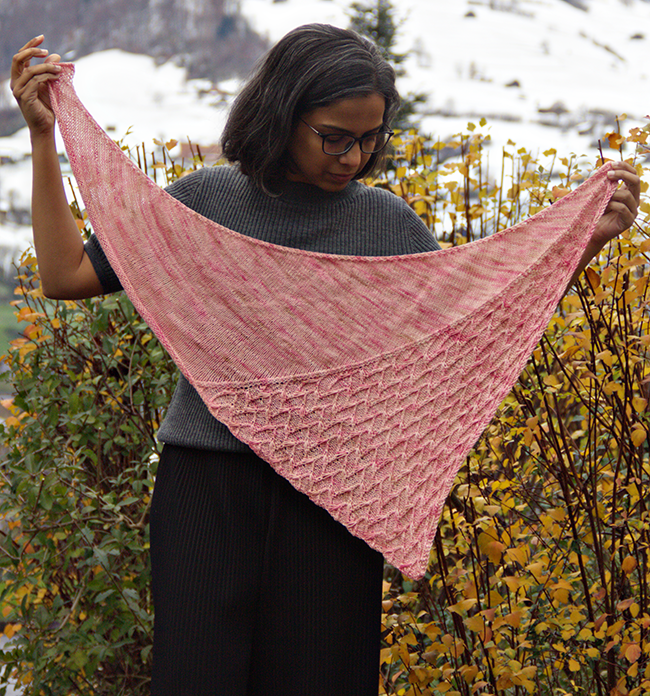
Setup
CO 6 sts using knitted cast-on, or your preferred method.
Row 1 [RS]: Sl1, kfb, k1, place marker, k3. 7 sts.
Row 2 [WS]: Sl1, k1, p2, pfb, k2. 8 sts.
Row 3: Sl1, k1, kfb, k2tog, slip marker, m1L, k3. 9 sts.
Row 4: Sl1, k1, p to last 3 sts, pfb, k2. 10 sts.
From here, the pattern is set. You still work the stitches before (when looking at the work on the RS) the marker the same way, and work the charted pattern after the marker.
Row 1 [RS]: Sl 1, k1, kfb, k to 2 sts before marker, k2tog; work Setup chart to end of row. 1 st increased.
Row 2 [WS]: Work Setup chart to marker, p to last 3 sts, pfb, k2. 1 st increased.
Work Setup chart.
Shawl Body:
Row 1 [RS]: Sl 1, k1, kfb, k to 2 sts before marker, k2tog; work Main chart to end of row. 1 st increased.
Row 2 [WS]: Work Main chart to marker, p to last 3 sts, pfb, k2. 1 st increased.
Continue in pattern as set, repeating Rows 1-48 of Main Chart, until your shawl is as big as you wish or you have just about run out of yarn. You can cast off after any WS row, but to have a complete lace section, avoid casting off after the 2nd, 8th, 14th, 20th, 26th, 32nd, 38th or 44th .
Leave yourself enough yarn that's approximately 5 times the width of the final row to bind off.
Bind off with larger needles, using lace bind off method.

FINISHING
Soak the shawl in lukewarm water for 15 mins. Mix a wool or a gentle fabric wash in the water, if needed. Gently roll the shawl in a thick towel to squeeze out all the water. Lay flat to dry on a blocking mat or a thick towel. Stretch fabric to open up patterning. Use pins or blocking wires to hold the edges in the desired shape. Once dry, weave in ends.
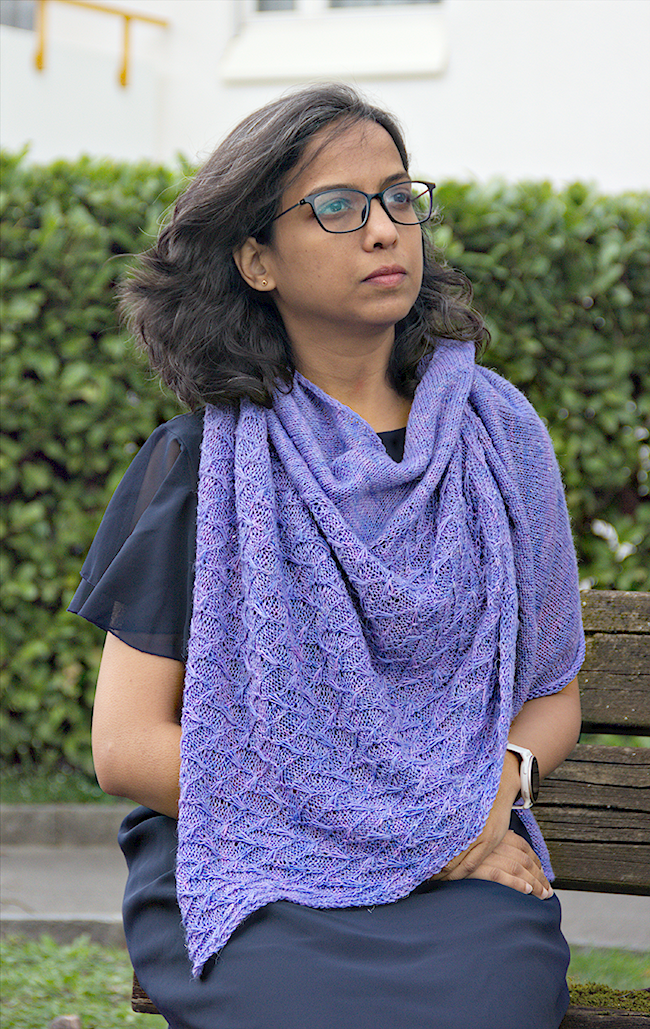
ABOUT THE DESIGNER
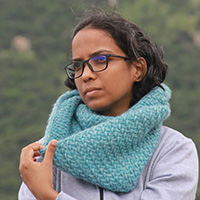 Anjali is a self-taught knitter and has been knitting and designing for more than 15 years. While she lived in India, she hardly got a chance to wear her handknits. She moved to Switzerland with her husband and son a year ago and has been seen flaunting her handknits even when the weather doesn't call for it.
Anjali is a self-taught knitter and has been knitting and designing for more than 15 years. While she lived in India, she hardly got a chance to wear her handknits. She moved to Switzerland with her husband and son a year ago and has been seen flaunting her handknits even when the weather doesn't call for it.
Find more of her work on Ravelry.
Pattern & images © 2024 Anjali M







